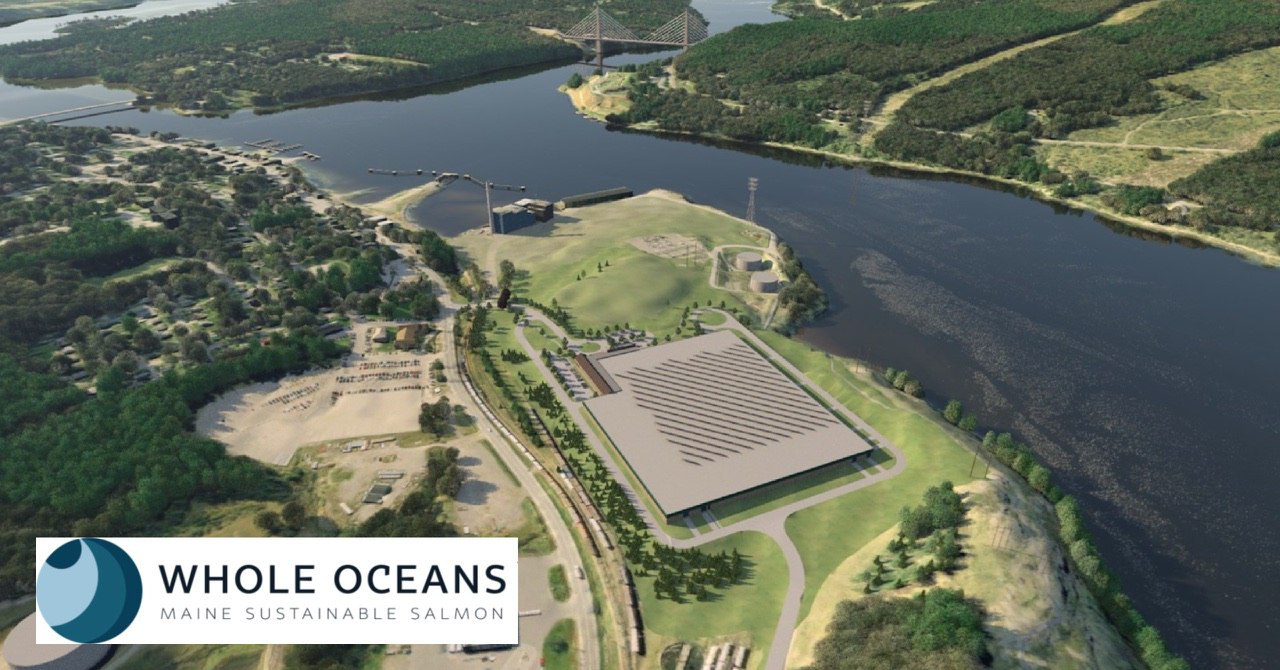The community of Bucksport and fans of land-based aquaculture everywhere may have the 2008 recession to thank for one of two new onshore Atlantic salmon production facilities coming to Maine.
Rob Piasio started his career as an investment banker. But he decided to take some time off in 2011 in the aftermath of the recession to consider a new career path.
“One of the first sectors I looked at was aquaculture,” said Piasio, now the CEO of Whole Oceans, a Maine-based aquaculture start-up.
Under his investment banking hat, Piasio had done some financing for Marine Harvest.
“I learned a lot about aquaculture at that time and found it — the industry — very compelling,” Piasio said. “I really liked the story, the economics, the opportunities within aquaculture.”
Opportunity and potential are the keys to Piasio’s mission.
“Whole Oceans’ goal, if you will, ultimately is to capture 10 percent of the US Atlantic salmon market — 50,000 metric tons,” he said.
The sudden influx of onshore salmon farming opportunities in the state may give an air of overnight success — Whole Oceans’ announcement came less than a month after Nordic Aquaculture announced their purchase of a site just a few miles down the road in Belfast.
But this is far from a fly-by-night mission. Piasio and his team have spent years carefully evaluating the investment, researching sites and building relationships in the state.
“Before we settled on Bucksport, we spent three years looking around Maine for potential sites,” Piasio said. “Bucksport by a wide margin was the best. One of the reasons is water supply.”
The former paper mill site includes extensive infrastructure for water intake. According to Piasio, the mill had the capacity for 72 million gallons a day of brackish water from the Penobscot River and 18 million gallons of freshwater a day through a pipeline from nearby Silver Lake.
That would supply “many multiples of whatever production potential we would put in Bucksport,” he said. (Both inputs will have extensive water conditioning to remove contaminants, including mercury.)
So why now? According to Piasio, the technology has reached a tipping point.
“Land-based technology has been around for a very long time,” Piasio said. “Previously, land-based solutions for full grow-out were not cost competitive versus other methodologies. That’s changing, and it’s changing fairly rapidly as improvements in land-based technology continue, efficiencies are increasing.”
“And on the other side of the equation, the potential for expansion of offshore aquaculture is to some extent limited by the availability of new permits,” Piasio said. “If you’re going to grow the U.S. domestic salmon production market, you have limited potential to do so with offshore operations.”
While they may be competing in the market with Nordic Aquaculture just a few miles down the road, they can also collaborate locally.
“One aspect that we’ve actively sought to develop in Maine is this sort of magnet cluster… for land-based aquaculture,” Piasio said. “We’ll be able to leverage buyers and feed agreements, all sorts of input costs. In addition, and very importantly, we can leverage workforce development together.”
The Whole Oceans site will include a hatchery and will be capable of full grow out — egg to harvest. The final product in the first run will be 5,000 metric tons of head-on, gutted farmed Atlantic salmon.
The first goal of 5,000 tons will require about a $75 million investment. The 50,000-ton goal is the company’s 20-year goal.
The company hopes to break ground in August this year, starting by leveling the Bucksport mill site in the hopes of beginning construction before first frost.
“Typically speaking, from the time you start construction, that’s approximately a year before you start to populate the tanks with fish,” Piasio said. “All in, three years from the time you start construction to harvest.”
They hope to minimize the visual impact of the site and extend the town’s waterfront walking trail alongside their new campus.
The first public meeting in Bucksport drew about 250 people and lasted about 2 1/2 hours.
“We want to be good neighbors,” Piasio said. “We intend to be the next hundred-year industry for Bucksport.”







